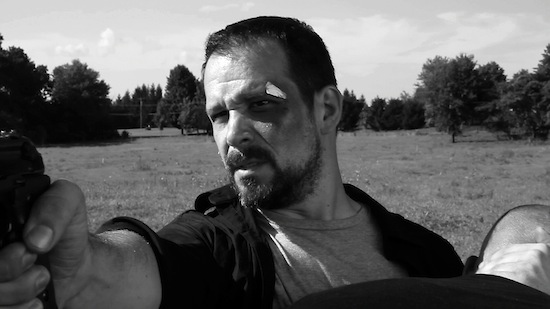
CUT TO BLACK, the latest film from Brooklyn-based writer/director/star Dan Eberle, is an Audience Award-winning film from this year’s Brooklyn Film Festival that is one of those films that shouldn’t be unnoticed by larger audiences because of its nearly hypnotic, somewhat dream-like imagery and narrative.
So much of the plot of Cut to Black is familiar, though not in a way that makes the film itself pedestrian or a series of well-worn plot points. Curiously, it both adheres to and contradicts expectations. Bill (Eberle) is an ex-New York cop who has been left penniless and emotionally broken from his actions on a case that is only referred to as “the interborough case,” which got him thrown off the force. One of the few details we’re told about the case is that Bill took the fall for John Lord (James Alba), a powerful political figure. In addition, Bill’s recurring nosebleeds also point to a potentially serious health problem. However, a former colleague from the force, Gunther (Beau Allulli), approaches Bill with a request: Lord will pay Bill a large sum of money to investigate a problem his estranged daughter Jessica (Jilliane Gill) has with a stalker. Despite his hesitations, Bill takes the offer, and upon meeting Jessica he begins to realize that the stalker is the least of her worries. Jessica’s boyfriend Duane (Joe Stipek) is involved in some bad business himself, and her estranged father discovering more about her than she wants him to know adds to her dilemmas.

Cut to Black is shot in black and white, which is likely a nod to its noir elements, but unlike traditional noir films (or even more recent noir-inspired films like Road to Perdition, Sin City, and Drive), the cinematography is shot in high contrast and avoids an overabundance of shadow. Much of the film takes place during the day, and scenes that take place at night are mostly interior, lending the film a relatively flat lightning style. Perhaps that serves as a reflection of the New York City of the present day, when much of the grime that made the streets dangerous (even in a creatively delightful way) has been scrubbed by reform politicians and multibillion dollar corporations. Though Cut to Black’s story is reminiscent of Taxi Driver’s, Travis Bickle’s grit-ridden New York seems to belong to another world. Yet Cut to Black’s New York has just as many seedy problems – one just has to look a little harder to find them (despite this, in the New York of Cut to Black it seems that locking the door to one’s apartment is uncommon!) The soundtrack is uncharacteristically jazz, adding to the juxtaposed atmosphere of Cut to Black’s New York. As Eberle said in his interview with VIMOOZ, “Because of these elemental contradictions, the overall experience of the film is transporting. ‘CUT TO BLACK’ becomes a world of its own.”
Reflecting real-life crimes, not all of the pieces of the crimes in Cut to Black fit together logically. In fact, viewers might find it jarring for a film to follow a private investigator without the convoluted plot twists audiences have come to expect from crime procedural films and television shows. Not everything can be chalked up to delicately planned elements of an overarching antagonist’s master plan. Jessica’s life isn’t simply plagued by a stalker, her life is a sum of a series of self-destructive decisions stemming from her estranged relationship with her powerful father. In that sense, the fact that the mysteries don’t fit together adds to the intrigue.
Like many noir protagonists, Bill is far from a “hero” though it’s clear that he seeks redemption for his past. He speaks in a “hush-harsh” voice, and though only in his thirties his visual appearance and body language are weathered. Jessica is his “damsel in distress,” yet they have such a tenuous personal connection that it seems he only becomes her “white hat” because he had no other cause to champion as his health declines and his life falls apart.
The film’s final third is untraditional in the sense that it raises far more questions than it answers. Bill needs a large sum of money and is able to procure it from the very people whom he brought down in the infamous “interborough case,” including an otherwise beautiful woman covered in sores. Though this borders on a “deux ex machine” resolution, it doesn’t bother me because it’s more intriguing than it is convenient. Like the mystery, Bill’s past is deeper and far darker than we could have possibly expected.
Cut to Black immediately demand a second viewing, not to review the clues (as with other mystery films), but to gain a better understanding of Bill’s action now that one understands more about his past. It won’t answer every question, nor should it, which is the mark of a storyteller whom is confident in his material.